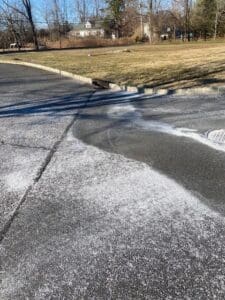If you manage a residential community or a business you will undoubtedly encounter oils spots on your pavement. You may even encounter them in your own driveway! An “oil spot” can come from motor oil, antifreeze or even kitchen oils that have absorbed into pavement. Here is some good news for you: if you find an oil spot early, you can greatly minimize its damage to your pavement. Yes, oil spots can and will damage pavement if not removed, leading to the need of a patch.
Here is a step-by-step guide to follow once you notice an oil spot on your pavement:
- If you find the oil spot within the first three days, try this: combine warm water and dish detergent in a bucket and invest in a soft, durable broom. Gently use the broom to brush the detergent water over the oil spot, scrubbing gently. Rinse the detergent away with clean water and allow the spot to dry.
- If you find the spot after its been there more than 3 or 4 days, sprinkle kitty litter or speedy dry on the oil spot and gently scrub with a soft broom. Sweep away the kitty litter then wash and rinse as outlined in the step above.
- Once the spot is clean and dry, take a screwdriver and try to penetrate through the pavement where the spot was (or in some cases still is). If the screwdriver penetrates the pavement, you’ll definitely need a patch to keep it from further deteriorating and leading to more widespread cracking and damage.
- If the screwdriver does not penetrate, you’re in luck. You’ll most likely just need to have an oil spot primer applied followed by a layer of sealcoat. Oil spot primer works 75% of the time to allow sealcoat to adhere to a spot. If the sealcoat won’t adhere, you will need to have the spot patched.
It’s important to note that any spot will require a layer of sealcoat, but not all will require patching. If you catch the problem quickly enough, you can minimize further damage and save money on repairing your pavement.




